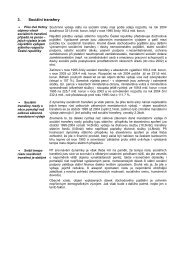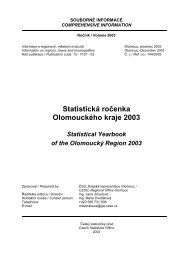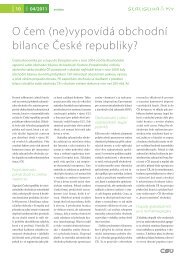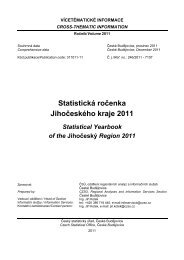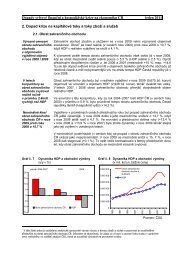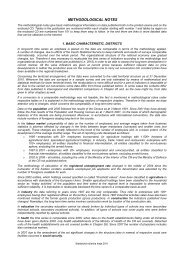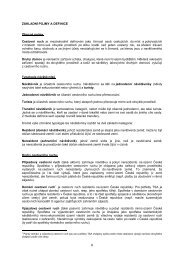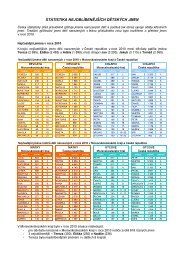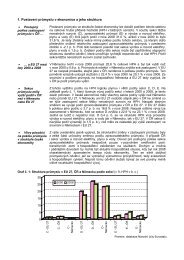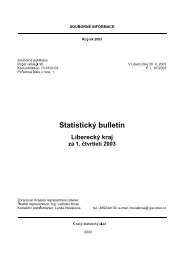Statistická ročenka Olomouckého kraje 2011 - Český statistický úřad
Statistická ročenka Olomouckého kraje 2011 - Český statistický úřad
Statistická ročenka Olomouckého kraje 2011 - Český statistický úřad
You also want an ePaper? Increase the reach of your titles
YUMPU automatically turns print PDFs into web optimized ePapers that Google loves.
of which is similar to that of municipal waste and which is generated in non-production activities of legal or natural<br />
persons holding a business licence.<br />
The industry of water supply and sewerage systems involves water management activities related to the<br />
administration and operation of water supply and sewerage collection systems that means with the providing for sufficient<br />
supply of quality drinking water and for removal of waste water and its treatment. Public water supply systems and<br />
sewerage systems include water supply systems and sewerage systems established and run in the public interest. The<br />
water produced includes both invoiced and non-invoiced water. The sum of data for invoiced and non-invoiced water<br />
may differ from amounts of the water produced for an amount of water taken from other organizations, or for water<br />
handed over to other organizations.<br />
The waste water treatment plant (WWTP) shall mean premises and equipment serving for waste water treatment<br />
having the mechanical, biological, and/or further stage of treatment. Equipment used for coarse pre-treatment of waste<br />
water (racks, grit traps, oil traps, etc.), cesspools, sumps, and simple devices with a mechanical function, which are not<br />
monitored and operated regularly, are not considered to be waste water treatment plants.<br />
The WWTP capacity refers to the design capacity (m 3 /day). A higher capacity than the design one is given where<br />
implemented intensification measures have been approved by the water authority.<br />
Data on how respective municipalities are equipped with technical infrastructure devices and instruments (water mains,<br />
sewerage systems, natural gas grids) were measured by an extraordinary supplement to the statistical questionnaire<br />
VI 1-01.<br />
4. POPULATION<br />
The data showing the size and structure of the population are derived from population censuses, which are followed by<br />
annual statistical balances of data on births, marriages, divorces, deaths, and migration. The data sources are statistical<br />
reports from registries unless otherwise stated.<br />
All data refer to the resident population of the Czech Republic, irrespective of citizenship. Since 2001 the following are<br />
included: foreigners with asylum granted, foreigners with visa over 90 days and since 1 May 2004 also citizens of the<br />
European Union with temporary stay and citizens of third countries with long-term stay on the territory of the Czech<br />
Republic.<br />
Mid-year population is the number of inhabitants of the given territory as balanced as at 1 July of the reference year.<br />
Natural increase/decrease of the population is the difference between live births and the total number of deaths. Total<br />
increase of the population is the sum of the natural increase and increase by migration. Migration is a change of<br />
permanent residence or long-term stay of a person over the borders of the given territory. The source of the data on<br />
migration is the Population Database Information System of the Ministry of the Interior of the CR.<br />
A live birth - a foetus that after delivery shows at least one sign of life and its birth weight is 500g or more, or lower than<br />
500g, if it survives 24 hours after delivery. A stillbirth - a foetus showing no sign of life and its birth weight is 1000g or<br />
more. As for the territory, a born child is included in the register according to the permanent residence of the mother at<br />
the delivery. Total fertility rate is the average number of children that would be born alive to a woman provided that agespecific<br />
fertility rates in a reference calendar year remain unchanged during her childbearing period (15-49 years of age).<br />
The abortion is termination of pregnancy, which is classified by a physician (based on meeting of respective criteria) as<br />
an abortion. Data on abortions are taken over from data of the Institute of Health Information and Statistics of the CR<br />
(HIS). Total abortion rate is the average number of abortions that a woman would have provided that age-specific<br />
abortion rates recorded in a reference calendar year remain unchanged during her childbearing period (15–49 years of<br />
age).<br />
Stillbirth rate is the number of stillbirths per 1 000 births in total. Infant mortality rate is the number of deaths among<br />
children under 1 year of age per 1 000 live births. Neonatal mortality rate is the number of deaths among children under<br />
28 days of age per 1 000 live births.<br />
Data on deaths analysed by cause are classified according to the 10th decennial revision of the International Statistical<br />
Classification of Diseases and Related Health Problems (ICD-10) in force since 1 January 1994.<br />
Index of ageing is the ratio of the number of persons aged 65+ per 100 persons aged 0–14. Life expectancy shows<br />
the number of years to be lived by an x-year-old individual, given the mortality conditions of the reference period. With<br />
regards to elimination of random deviations, an average for two-year periods is used for regions and for five-year periods<br />
for districts.<br />
Marriages are included in a respective territory according to the place of residence of the groom. Data on divorces are<br />
taken over from the Information System of the Ministry of Justice of the CR. They are broken down by territory according<br />
to the last common place of residence of the spouses.<br />
Such a person is deemed to be a foreigner in the Czech Republic who has other than Czech citizenship or a person<br />
without citizenship and also a person having more than one citizenship, none of which is Czech.<br />
In tables 4-11 and 4-12 the total number of foreigners includes foreigners with permanent residence, citizens of the<br />
EU/EEA and Switzerland and their dependants with temporary residence, citizens of “third countries” with long-term<br />
residence or visas for stay over 90 days. Data come from the records of the Directorate of Alien Police.<br />
<strong>Statistická</strong> <strong>ročenka</strong> <strong>Olomouckého</strong> <strong>kraje</strong> <strong>2011</strong> 193



